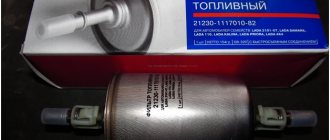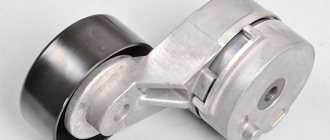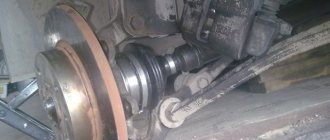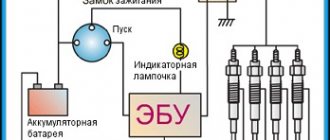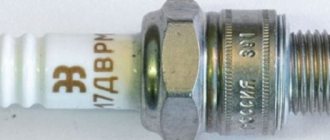Published: 01/28/2021
- Why does the candle break?
- Signs of malfunctions and their causes
- Video “Step-by-step instructions for assembling the charger”
- Self-replacement
- Tips for properly replacing spark plugs
- Diagnostics of glow plugs
- Automatic transmission cleaning methods
- Which spark plugs are worth buying?
- The principle of operation of candles with a monospiral and double
- When to change spark plugs: main signs
- Device for checking glow plugs in a diesel engine - multimeter, checking spark plugs with a device
- Control system
- Checking with a multimeter (tester)
- Long but reliable
- Removing old parts
- Sections
- For what reasons does a diesel engine smoke gray or blue smoke?
- Methods for checking glow plugs for diesel engines
- VIDEO: How to remove scratches from plastic in a car interior?
- When to change spark plugs: main signs
Why does the candle break?
There may be several reasons for this. Let's look at what could cause you to end up with a broken candle:
- Design features
. Many glow plug models consist of several parts. The base is a threaded rod, a cylinder in the form of a nut is attached to it, and it is with its help that the part is unscrewed. But often this cylinder simply breaks off its mounts, as a result of which it begins to rotate freely. Or it just breaks off; - Low quality parts
. Nowadays many people use cheap Chinese candles. They do not have sufficient safety margin. And when unscrewed they can break; - " 10 years without major repairs
." Glow plugs are quite reliable, so you can often find foreign cars 10-20 years old where this structural element has never been removed. Accordingly, they stick to the thread and soot collects on them. All this leads to problems when unscrewing, and, accordingly, it breaks off right on the engine. Natural “metal fatigue” also plays a role here; - Often drivers themselves are to blame for what happened. It is believed that it is easier to remove spark plugs on a hot engine, but they forget about reducing the strength of the spark plug itself. As a result, the spare part is broken.
Signs of malfunctions and their causes
It is best to identify the problem during the cold season. If one part is faulty, the diesel engine will have difficulty starting and will be extremely unstable. If two or more elements are inoperative, the engine may not start at all. The second sign is thick white smoke from the exhaust pipe. If both symptoms are present, all glow plugs must be checked. The reasons for their malfunction may be:
- resource development;
- problems with the spiral: poor heating, short circuit with the rod or its rupture (burnout) - the latter malfunction is associated with an excessively high temperature of the gases, which is due to large deposits on the cylinder walls;
- violation of the integrity of electrical wiring;
- breakdown of control equipment: untimely injection or insufficient injection pressure.
How to detect a fault
Weak heating of the coil is detected by its heating time, which should be no more than 50 seconds. To make sure that the incandescent element is working properly, unscrew it and connect the central contact to the battery positive and the housing to the negative. If heating is normal and occurs in less than a minute, then the problem is faulty electrical wiring or poor contact. How else can you check the serviceability of the starting elements of a diesel engine without unscrewing them? Prepare your multimeter and switch it to resistance measurement mode. Disconnect the central wire from the contact and touch it with the positive probe (minus - on the body). If the instrument needle does not move, the part is faulty.
How to check products before purchasing?
When choosing glow plugs for a diesel engine, the price of which depends on the manufacturer and variety, you should definitely check these details. You should not buy fake items, they will not last long. It is better to immediately pay attention to the original parts.
To distinguish the original element from a fake, you should pay attention to the metal with which the candle is processed. It should not have poor-quality engraving, burrs or other defects. When purchasing a kit, both units must be identical. It is also worth paying attention to the packaging: it should contain all the information about the candle, without any errors.
Checking diesel glow plugs is done using a voltmeter, ohmmeter or multimeter. The appropriate operating mode is configured. You can also check the performance of the spark plug without connecting it to the car's electrical network. To do this, you need to connect the positive probe to the electrode, and the negative probe to the frame or engine block. Even a non-working element has resistance, although it should be small. If it is not there at all, this indicates a malfunction of the glow plug.
In some instructions, the manufacturers themselves write about how to check the glow plug. There are several ways.
Self-replacement
Please note that when replacing, it is advisable to immediately replace all spark plugs with new ones, regardless of their visual condition. Glow plugs are selected according to their suitability for installation on a particular type of diesel engine
Removing protection
Glow plugs are often located at the top of the cylinder head (usually near the diesel injectors). They may not be visible if the motor is covered on top with a plastic cover or protective casing. This protection must be removed to provide access.
Disconnecting the battery terminals
Since glow plugs are an electric heating element, you will need to disconnect the negative terminal from the battery. Then the small nuts are unscrewed, which secure the tips of the high-voltage wires to the contact rods of the glow plugs. The wire connects to the top of the spark plug. This nut must be unscrewed with a wrench, and the wire itself can be moved slightly so that it does not interfere with further removal of the glow plugs.
Unscrewing glow plugs
The next step is to unscrew the spark plugs using a ratchet wrench. It is necessary to unscrew it very carefully so as not to damage the threads in the cylinder head. There is also a risk of breaking the spark plug itself, which may result in additional difficulties with subsequent drilling of the rod and restoration of the thread.
Cleaning contacts
Next, it is necessary to clean the contacts on each high-voltage wire of the glow plug from contamination. This is necessary for the new spark plugs to be fully operational after they are installed on a diesel engine. If the contact is “stuck”, then it can be removed without much difficulty using a flat-head screwdriver.
After dismantling, a visual inspection of the removed glow plugs is carried out. If even only one of them shows extensions of the rod, the rod is swollen or deformed, melted, cracks or other defects are noticeable, then all spark plugs are replaced with new ones. Also a reason for replacement is the presence of abundant carbon deposits in the place where the tip is connected to the spark plug body, or any noticeable damage to the tip.
Removing dirt from spark plug holes
Separately, it is worth noting the procedure for cleaning the holes for installing candles from carbon deposits. To do this, you will need a special reamer, the length of which will allow you to effectively clean the spark plug wells. Before screwing in, the reamer must be lubricated. The specified reamer must be screwed into each hole. For the procedure, it is better to use a standard scan rather than a universal one. If this is possible, it is additionally necessary to remove deposits from the channels using compressed air.
Installing new glow plugs
After cleaning, new and/or pre-tested glow plugs are installed on the diesel engine. It is necessary to tighten the spark plugs until slight resistance appears. The tightening torque is adjusted with a torque wrench and is 15 Nm. Over-tightening may lead to the fact that during the next replacement there will be a risk of the spark plug breaking in the well when attempting to dismantle it.
When the installation of new elements on all cylinders is completed, the cleaned tips of the spark plug wires are put back into place and secured with a nut and wrench. It is necessary to make sure that the wire tips are tightly secured, and that the spark plug contacts are completely closed.
Then you can connect the negative terminal to the battery. The next step is to check the installed spark plugs. You should check it in the normal manner: turn the ignition key, start the diesel engine, and then evaluate the operation of the internal combustion engine in warm-up mode. If the engine starts confidently, runs smoothly and without failures, then the glow plugs are fully operational. Otherwise, it is necessary to re-diagnosis the diesel internal combustion engine to find a potential malfunction.
What you need to know before starting work
An urgent need to replace glow plugs with your own hands may arise in the cold season, since the candles increase the temperature inside the cylinder for effective self-ignition of the mixture of diesel fuel and compressed air when the internal combustion engine warms up. If more than one spark plug fails, the diesel engine will no longer start in winter. Glow plugs also affect the efficiency of fuel atomization in the cylinders.
To replace it yourself, you need to have a minimum set of available tools: a wrench, a socket wrench and a screwdriver. A complete set includes gloves, wrenches and socket wrenches (which have extensions and ratchet locks), a reamer and pliers. You will also need some graphite and high temperature grease.
It is worth adding that glow plugs are quite fragile
During the replacement process, they can be broken as a result of careless handling of the keys. Breakage of the spark plug inside the spark plug well will lead to the need to drill out the remaining contact rod using a drill and drill
Additional tools may also be required to repair damaged threads.
Some sources recommend changing the glow plugs of a diesel engine when the engine is warm. This is explained by the fact that the threads in the cylinder block may be more fragile compared to the spark plug body. Due to thermal expansion, spark plugs should come out easier on a heated diesel engine. Other manuals recommend replacing with a cold engine. Before starting work, be sure to read the instructions regarding replacing glow plugs on a specific diesel engine.
Tips for properly replacing spark plugs
Finally, we will give you some useful tips that will not only help you change spark plugs or glow plugs correctly, but will also help you avoid various troubles.
- Make sure that carbon deposits or dirt near the wells do not get into the combustion chamber under any circumstances. To do this, remove dust and dirt before removing the old spark plugs. If this happens, you can use a compressor to blow the dirt out. Or on a gasoline engine, you can try to start the engine without a spark plug, as a result of which the piston itself will throw the fuel mixture with dirt into the engine compartment.
- To replace spark plugs (this is especially true for spark plugs), use a special spark plug wrench (or at least a socket). The fact is that these devices not only make the work easier, but also tightly hold the spark plug directly, preventing it from falling into the engine compartment. As a rule, a spark plug wrench is included in a set when purchasing a car. If you don’t have it, buy it at a car store, it’s inexpensive.
- It is best to change spark plugs (both unscrewing and tightening) on a cold, not a hot, engine. This is due to the fact that warm threads are more susceptible to deformation.
- Regardless of how many spark plugs have failed, they all need to be changed at once. The reason is that they have approximately the same service life. And if one falls into disrepair, then soon the same will happen to the others.
- To make it easier to replace glow plugs, it is recommended to unscrew and screw them back in every six months to avoid sticking. Otherwise, when replaced, due to the fragility of this spare part, they may break right in the spark plug well.
- 3 days before replacing the glow plugs, it is recommended to soak them with penetrating lubricant 2-3 times a day.
When installing or replacing spark plugs, you need to select the correct tightening torque. If the tightening torque is too high, the spark plug may be damaged, and if the tightening torque is too low, it will cause poor heat dissipation and sealing. Most manufacturers indicate specific torque values on the packaging. We present for you a table from the well-known manufacturer DENSO, which you can use as a guide:
| Thread size | Recommended moment | Recommended speed | ||
| New candle | Used candle | |||
| Pad | M8, Type Y | 9…10 Nm | ±1 rev. | ±1/12 rev. |
| M10, Type U, N | 10…15 Nm | ±2/3 rev. | ±1/12 rev. | |
| M10, Stainless steel gasket | 10…15 Nm | ±3/4 turn | ±1/12 rev. | |
| M12, Type SXU, X, XE, XU, ZXE, ZXU | 15…20 Nm | ±1/3 rev. | ±1/12 rev. | |
| M14, Type FK, J, K, KJ, P, PK, PKJ, PQ, Q, QJ, QL, S, SF, SK, SKJ, SV, SVK, VK, VKJ, W, ZT | 20…25 Nm | ±1/2 turn | ±1/12 rev. | |
| M14, Stainless steel gasket | 20…25 Nm | ±2/3 rev. | ±1/12 rev. | |
| M18, Type L, M, MA, MW | 30…40 Nm | ±1/4 turn | ±1/12 rev. | |
| Conical socket | M14, Type PT, PTJ, T | 20…30 Nm | ±1/16 rev. | ±1/16 rev. |
| M18, Type MA | 30…40 Nm | ±1/4 turn | ±1/12 rev. |
Sleeve for cleaning spark plug well
One more tip. In auto stores you can find a “Spark Plug Well Repair Kit”. Among other tools, it includes a sword. Even if the candle thread is normal, we still recommend that you go through it with this tool. This is necessary in order to clean dirt and heat from the threads. At the same time, lubricate the sword with lubricant (for example, graphite) so that the debris clings to it. Carry out the operation in several stages. For example, one turn, cleaning the tool, two turns - the same. The main thing is not to rush, but to do the cleaning efficiently.
It is advisable, but not necessary, to lubricate the threads of the spark plugs with a lubricant that can withstand significant temperature conditions. For example, special lubricants can be used for this.
Sometimes situations arise when, after replacing the spark plugs, the engine begins to “trouble” or does not start at all. There are different options here. In particular:
- the new or repaired spark plug is damaged;
- during installation you damaged the integrity of the electrical wiring (possibly the terminal);
- poor contact between terminal and spark plug;
- when replacing several spark plugs at the same time, you mixed up the contact wires;
- Incorrect spark plug tightening torque.
In any case, you need to repeat the procedure for dismantling the problematic spark plug, then check it and perform an audit.
Results
Replacing spark plugs and glow plugs is a simple procedure that is accessible to anyone, even a novice car enthusiast. This requires a minimum of tools and experience. This way you can save money, because the price of replacing spark plugs at a service station is quite high. It is much more important in this situation to identify problems in time and inspect or replace spark plugs. Follow the replacement schedule recommended by your vehicle manufacturer. Also, to extend the service life, use high-quality fuel and fill in good oil.
Diagnostics of glow plugs
The principle of operation of spark plugs is quite simple and consists in heating the air to temperatures of about a thousand degrees - at such values in the combustion chamber of a diesel engine, self-ignition of the air-fuel mixture occurs. In this case, you have to control the coolant temperature, which should not exceed 80°C. Regardless of the type of construction (pin or ceramic), any SV consists of a housing to which an incandescent filament consisting of two thermistors is attached. One of the resistors is characterized by a constant resistance, the other has a dynamically changing resistance, regulated through the use of the so-called temperature coefficient. This feature allows you to correlate the temperature of the spark plug with the degree of engine warm-up, which makes its use more profitable in terms of energy savings. Unfortunately, the malfunction of at least one spark plug makes starting the diesel power unit impossible
That’s why it’s so important to monitor their condition, especially during cold snaps. Although the frequency of planned replacement is quite large (the scheduled periods are indicated in the user manual), it is necessary to diagnose their condition much more often
Currently, there are two main methods for checking the condition of glow plugs:
- the first requires the participation of two people. One of them unscrews the injectors, the second sits behind the wheel and turns on the mass. Anyone standing near the engine compartment should carefully examine the injector holes. If the spark plugs are in good working order, they should have a red tint. The main advantage of this method is its high information content, and the disadvantage is the complexity of removing the injectors. In addition, on some models it may be difficult to access the holes, so this method is not always applicable;
- the second method is less labor-intensive, but its use requires a multimeter or a conventional lamp tester. The device switches to short-circuit mode, one of the terminals is short-circuited to the motor housing, the other is applied to the tip of the CH. If the light comes on (or the beep sounds), the spark plug is working. Otherwise, it can be argued that it is broken.
Note that on modern cars, a malfunction of one of the CVs is indicated by a light indicator located on the dashboard. In such cases, diagnosing candles does not make sense.
Device
Outwardly, they are similar to those installed in a gasoline engine, but the design is somewhat more complicated. Glow plugs do not produce a spark; they are based on a heating element in the form of a spiral, which can be metal or enclosed in a ceramic “case”. In the first case, we are talking about two “curls”, one of which serves for heating, the second protects against overheating. The next type of product is a spiral placed in a ceramic shell, due to which heating occurs faster. The tip of the candle heats up to 1350 degrees. The design also includes an incandescent filament consisting of a pair of resistors. The first of them has a constant resistance. The second one has an adjustable temperature coefficient. That is, when the engine temperature changes, the heating of the starting elements also changes. This allows you to save energy.
Ceramic products are considered more promising: such spark plugs not only quickly heat up the tip, which allows you to easily start a diesel power unit at low temperatures, they also have other advantages: these spare parts are suitable for Euro 5 and 6 standards. This is due to the fact that the products with a ceramic shell guarantee an intermediate glow mode. This optimizes the process of restoring the filter, which is “engaged” in reducing the soot content in the exhaust of Sang Yong Aktion, Kyron or other similar cars.
Control
The operation of glow plugs is controlled by the ECU, a separate unit or a special relay. Their work is related to data received from sensors that determine the crankshaft speed and coolant temperature. Many car models have a function to maintain heat after starting to reduce the noise level from an unheated engine (Land Rover Freelanders, and not only them, are guilty of this). When are glow plugs replaced and why do they fail?
Article on the topic: Types of tread patterns
Automatic transmission cleaning methods
Proper automatic transmission maintenance involves cleaning the existing cavities of the box from accumulated dirt. A similar procedure is performed by passing a small amount of oil through the system and then draining it. Ideally, the car owner should dismantle the valve body, open it, manually clean all internal elements, wash the automatic transmission filter, then blow it with air, wipe it with gasoline, run oil through the system, and only then reassemble the box in the reverse order.
In rare cases, to clean automatic transmissions, special auto chemicals and flushing additives are added to old oil, which, while in the lubricant, soften deposits, quickly removing dirt.
All that remains for the car owner to do is to perform a timely oil change.
This method of washing an automatic transmission can be used to prevent serious contamination. If the transmission is already difficult to shift into upshifts and downshifts, you need to open it and clean it manually.
Which spark plugs are worth buying?
NGK and DENSO spark plugs are very popular among car enthusiasts all over the world. Both manufacturers use high-quality materials, do not allow defects when assembling the product, and carefully think through the design. As a result, the following candles:
- provide stable ignition at any temperature;
- have good heat resistance;
- resistant to erosion;
- have an increased service life.
The benefits of such candles are especially noticeable in winter. The car starts in any conditions. You can find candles on the market cheaper than NGK and DENSO, but it’s not worth taking risks and saving. High quality always has its justified price.
You can always purchase products from NGK, DENSO, as well as other manufacturers in the SamAuto store. If you have any questions, our consultants will definitely be able to answer them.
The principle of operation of candles with a monospiral and double
The operation of a glow plug is similar to the operation of an electric heater. An electric current passes through the coil and heats it to operating temperature. Starting a diesel engine largely depends on the model and age of the car. In older models, the glow plug starts firing every time it is started. In modern cars, at above-zero temperatures, additional heating is not required.
The heating elements are controlled by a special unit. When you turn the ignition key, they are connected to the battery, and the corresponding light on the instrument panel lights up. When it goes out, the combustion chamber is warmed up and the engine is ready to start. True, as experience shows, this relay cannot be completely trusted.
Candles come in open and closed types. Open ones are used on older cars. Closed-type heating elements consist of a housing and a spiral, which is protected by a casing. Inside there is ceramic powder with good heat dissipation. The spiral is made of refractory material: nickel, iron-cobalt or iron-chromium-aluminum alloys. The heating time and power consumption depend on the quality of the material used, the shape of the core and the adjustable spiral. Closed type candles are called pin candles, they come in two types:
- with a metal spiral;
- ceramic.
In turn, they can be mono-helix or double-helix. For mono-coil heating elements, one coil is used. With its help, both incandescence and self-regulation are provided. Thanks to the spiral, the desired temperature is achieved and the maximum is limited. In addition, the spiral increases the service life of the heating elements. This design is used in most engines and meets the requirements for speed and reliability of heating. With the development of technology, heating elements with a monospiral are being replaced by those with a double spiral, which have better heating temperature control.
If you provide the adjustment and necessary options when creating a spiral, then the design with a double spiral makes it possible to obtain the desired temperature of the working part of the core throughout the entire period of engine starting.
Resistive material is used to make spirals.
Spark plug life and reasons for failure
According to experts, it is very difficult to speak clearly about the life of glow plugs. They are changed every year or two, depending on the quality of the product itself. If we talk about the service life of spark plugs based on mileage, we can come to the following pattern:
- Products with a metal spiral become unusable after 50-80 thousand kilometers;
- Products with a ceramic spiral last twice as long as metal ones - up to 160 thousand kilometers;
- Some Japanese glow plugs for premium cars can last 240 thousand kilometers.
Let us only note that the breakdown of one spark plug will not have a special effect on the engine. Two working candles guarantee operation in the warm season. However, in all cases, it is advisable to change them as a whole set, since even one non-working part will affect the consistency of diesel fuel, and, accordingly, the operation of the engine.
The glow plug will work long enough if the following conditions are met:
- Fuel injectors are working properly. A clogged injector does not spray fuel, but streams it directly onto the spark plug, causing it to burn out;
- The candle is clean. Combustion products can be deposited on the working part, which is why the part can eventually close on the “minus”, that is, the car body, and fail forever;
- The installation was carried out incorrectly. The candle is a rather delicate detail. Excessive force on the key will simply break it;
- Tightness of engine components. Oil contamination is a common cause of failure of many car parts. For example, oil leaks also burn spark plugs in gasoline/gas engines.
A serviceable part is clean, its tip has no swelling. External damage usually indicates excessive tightening during installation, and a broken tip indicates problems with fuel injection. We advise you to check the spark plugs every year for these changes.
As practice shows, most often failure occurs due to incorrect selection and subsequent overheating. We did not describe this point above simply because the rule applies to all consumers of energy from the vehicle’s on-board electrical network: always choose a spare part that meets the vehicle’s parameters. If the rule is not followed, any candle fails very early.
Device for checking glow plugs in a diesel engine - multimeter, checking spark plugs with a device
A simpler method. If there is no time or tools to remove the spark plugs, diagnostics using a multimeter comes to the rescue.
They use the method for each candle separately - or for all of them at once, connecting the heating elements with a brass (or copper) busbar.
- Disconnect the power supply wire from the spark plugs.
- Place the multimeter in the appropriate position for the resistance test being carried out.
- The circuit short circuit test mode is selected.
- Next, touch the spark plug body with the 1st probe, and its cap with the 2nd probe.
- If the circuit is closed, we can talk about its performance.
- If the circuit is not closed, they indicate the need for replacement.
The main disadvantage of the testing method is the difficulty of identifying problems with weakly glowing spark plugs. In such a situation, the tester shows no breakdown, and the heating element does not warm up the combustion chamber well.
Checking with a multimeter (tester)
The tester for checking diesel glow plugs is used in three modes:
- Measurement of resistance readings;
- Dialing method (if supported);
- Measurement of current consumption readings.
All methods can be applied without removing the product from the engine. But in this way we will only answer the question - “is the spark plug working or not.” It will not be possible to find out what condition it is in and the reasons for its breakdown.
Chain ringing
To check using the dialing method you need to:
- Disconnect the supply wire from the glow plug;
- Set the regulator on the tester to the desired position;
- Press the negative probe to the engine block, the positive probe to the electrode.
- The presence of sound indicates that the spiral is intact.
If you are using an analog tester, then you need to follow the arrow; its deviation indicates the integrity of the circuit.
This can also be done on a removed spark plug, only instead of a block, the probe must be attached to the body of the product.
The first and third methods are more informative, but they have their own characteristics that are important to know
Resistance measurement
Here it is important to understand the principle of the relationship between the ECU unit and the resistance of the spiral, which in a new glow plug should be in the range of 0.7-1.8 Ohms. The ECU is guided by the current consumed by the heating elements (A), which changes depending on their warming up
The amount of current is inversely proportional to the amount of resistance
The ECU focuses on the current consumed by the heating elements (A), which changes depending on their warming up. The amount of current is inversely proportional to the amount of resistance.
Those. Glow plugs are turned off when their resistance increases as a result of heating, and the current passing through the coil decreases. When a certain current value is reached, the ECU receives a signal that the spark plugs are warm and need to be turned off.
If the resistance, as a result of a malfunction of the heating elements, is too high (more than rated), then the current strength decreases earlier than necessary.
At this moment, the ECU receives a signal (premature in our case) that the glow plugs are warmed up and need to be turned off, which is what happens. At the same time, the air temperature in the cylinders remains insufficient for reliable engine starting.
Current consumption measurement
The most informative method, which involves starting a still cold engine. Those. There is no need to remove the glow plugs.
By measuring current consumption, you can quickly identify a faulty heating element. In this case, the reliability of the result obtained will approach 100%.
But here it is important to understand what types of glow plugs are installed in the engine and what their standard current consumption is. For example, if we take rod products, they can be single-pole and double-pole
For example, if we take rod products, they can be single-pole or double-pole.
The first ones are connected according to the classical scheme - ground on the body, one terminal coming off. Consume from 5 to 18 A.
The latter are determined by the presence of two terminals and can consume up to 50A.
To measure the current consumption, it is necessary to connect the tester in series in the “ammeter” mode into the electrical circuit that supplies the glow plug.
For this:
- Disconnect the power cable from the product;
- We switch the multimeter to ammeter mode;
- We connect one probe to the power wire, the second to the central terminal of the glow plug.
- An assistant will be needed. We start the car (the engine must be cold) and take readings from the device.
In the first seconds, the resistance on the electrode will be minimal, since the engine is still cold, and accordingly the tester will show the maximum current.
As the spark plug warms up, its resistance will increase and the current will drop. This will be displayed on the device. The reduction should take place without sudden changes, gradually. And then, at some stage, the current must stabilize.
It is better to write down the results of checking each spark plug so that they can be compared later. They should be as identical as possible.
If the behavior of a certain glow plug differs from others, then most likely only its middle or tip warms up. The absence of current will indicate an open circuit.
Here you will have to unscrew the product and recheck it, but visually observing the heating process. Typically this is already done using a directly connected battery (see below).
A brief tour of brands
As already mentioned, original candles are a priority. You will buy exactly what suits your vehicle.
You can save significantly by purchasing candles from Japanese brands Denso and NGK or German Beru. All three options are very good. We are especially pleased with NGK products - this company produces the most advanced parts for ignition systems, and a significant part of them is supplied directly to the factories of large automakers.
One cannot help but pay attention to the American company Champion and the German Bosch. These are clear winners of the “audience choice”, because their products make up the majority of the glow plug market in Russia and Ukraine.
Also, if you decide to save money, pay attention to the Danish company JP Group and the Polish Maxgear - their products are inferior to those of the above brands, but meet all quality standards. The best option for new diesel cars.
Long but reliable
The most reliable but also the most time-consuming is the battery test. Each spark plug is ringed individually, the degree of its glow is determined quite accurately, but they all must be removed from their places, and in some models this requires partial dismantling if some parts impede access. Therefore, such a check is usually combined with replacing spark plugs.
- For testing equipment, you will need a half-meter insulated wire;
- The candle is turned upward with its heating element and placed on the positive output of the battery;
- The prepared wire connects the mass of the battery and the side part of the spark plug body;
- The working state is manifested by rapid heating, and then by the glow of the spiral. If the process is slow, or only the tip of the heating element is hot, the spark plug must be replaced.
Removing old parts
It is important to follow the following steps:
How to remove spark plugs
It is necessary to pull the wire terminal from the power unit. The wire is grabbed as close to the connector as possible. The procedure is performed extremely carefully. The task is to remove the terminal. Under no circumstances should you pull the wire when removing it from the plug. This way you can cause serious damage to him.
A socket wrench is placed on the part being removed. Use a ratchet to unscrew the part from the body.
All these actions are performed slowly and very carefully.
When checking here, it is worth making sure whether the plugs need to be replaced. This is easy to find out: one part from the whole set is removed and carefully studied. Its gap and the condition of the contacts are inspected. If contact burnout is detected, you will have to urgently purchase new plugs. Burnt-out plugs are removed one at a time, one by one
It is important to detect their positions
The correct operation of spark sources is carried out in a certain algorithm. And if the wires are connected incorrectly, the engine will function with serious interruptions. And eventually it may fail.
When replacing more than one part, pay special attention to the wires. They can be marked with a marker or small pieces of electrical tape.
Both the spark plug and each wire are designated in this way even before the replacement procedure. This way you will prevent negative consequences and incorrect connection of these components.
If such a connector cannot be removed with bare hands, then a special puller will help solve this dilemma.
Example:
Puller
This operation is performed very carefully. The thread must not be damaged.
Stage two. Extraction
The part to be replaced is removed. This action uses a special wrench with an attachment. It rotates counterclockwise. Huge efforts are not required here. You should not pull the candle out of its position. This will only ruin the thread. These manipulations are also performed extremely carefully. If there are difficulties, you can rotate clockwise and then counterclockwise again.
Stage three. Cleaning
This is where the spark plug hole is cleaned. Cleaning is mandatory even before installing new spark plugs. Use technical alcohol and the same rag again. And only after the dirt has been completely eliminated from the threads can you proceed to further actions.
The electrodes are carefully inspected for carbon deposits. In certain cases, spark plugs may not operate stably due to dirt accumulations between the electrodes.
If the side of the spark plug that is placed inside the engine is covered with oil, it means that the piston and oil rings are worn out. In this situation, resort to the services of specialists from the service. If these parts are in normal condition, then their color is brownish.
Methods for checking glow plugs for diesel engines
The failure of one or two glow plugs may not be noticeable in relatively warm weather. And when frost sets in, difficulties immediately arise in starting the diesel engine.
We will describe three different ways to test the performance of glow plugs. The choice of each of them depends on whether the motorist has certain devices, tools, skills and free time.
Method 1 - Checking glow plugs using a battery
The most accurate and clear picture of the serviceability of heating elements for a diesel engine is given by checking the battery. Each spark plug is checked separately, and the car enthusiast sees the degree of its glow.
The disadvantage of this diagnostic method is the need to unscrew all the glow plugs. This will require a significant amount of time in some cars, as well as the dismantling of some parts that make access to the heating elements difficult.
- To carry out the tests, you will need an insulated wire about 0.5 m long.
- The glow plug is turned upside down by the heating element and installed with the central electrode on the positive terminal of the battery.
- Using an electric wire, you need to connect the negative terminal of the battery and the spark plug body (in the side part).
- If the heating element quickly heats up by more than half, then the spark plug is working.
- If there is no glow or only the tip of the element is heated, the spark plug needs to be replaced.
Below are easier ways to check glow plugs.
Method 2 - Checking the glow plugs with a multimeter
Sometimes there is no time or tools to remove the glow plugs from the head of a diesel engine. In this case, checking with a multimeter may be useful. The device is installed in the position for testing resistance (ohmmeter).
But first you need to disconnect the wire from the glow plugs that supplies current to the central electrode. Each heating element can be supplied with a separate wire, or all candles can be connected by a copper or brass busbar. Now all that remains is to connect the positive probe of the multimeter to the central electrode of the spark plug, and touch the negative probe to the side surface of the housing. If the arrow does not deviate or there is no reading on the digital display, then there is a breakdown in the heating element. The glow plug needs to be replaced.
The disadvantage of this method is the difficulty of identifying heating elements with low heat. The tester will show that there is no breakdown, and the spark plug will not warm up the combustion chamber sufficiently.
Method 3 - Checking the glow plugs for a “spark”
An old, tried-and-true way to check the health of glow plugs is the degree of sparking. To do this, you will need an insulated wire 0.5-1 m long, at both ends of which 1-2 cm of insulation is removed.
Now you need to free the glow plugs from the tire and supply wire. One end of the test wire is attached to the positive terminal of the battery, and the other end makes a tangential movement along the central electrode of the glow plug (see the video below). Thus we will be able to observe something like the following:
- A strong spark forms on a working heating element.
- If the spark plug is weakly heated, sparking will be insignificant.
- A completely faulty glow plug will have no spark at all.
This check can be safely done on old cars that do not have “brains” and a computer. In the video below, glow plugs are checked in this way on a diesel Nissan Primera.
The above methods for checking glow plugs allow you to independently discover the cause of poor starting of a diesel engine. If a faulty part is identified, the car owner will only have to replace the failed heating element. After this, starting the engine in the cold is usually not difficult.
Useful tips
- Before the onset of the cold season, the glow elements should be checked regardless of whether the diesel engine starts well or poorly.
- Checking on a diesel engine by assessing the spark is recommended only for older cars. You should not test heating solutions in this way on a “fresh” model, which is equipped with a complex electronic engine control system.
- If a malfunction is detected, it is optimal to replace the entire set, rather than one or two failed elements.
- Try to purchase products from well-known manufacturers, since cheap solutions have a noticeably shorter service life and often demonstrate low efficiency of the heating element.
Finally, we would like to add that in order to reliably start a diesel engine in winter, it is necessary to correctly select, charge and maintain a diesel battery, refill high-quality diesel fuel according to the season, and use anti-gels if necessary. Also, in the case of diesel engines, it is advisable to install a diesel fuel pre-heater or a Webasto-type engine pre-heating system.
When to change spark plugs: main signs
The car itself signals that the spark plugs need to be replaced or at least need to be checked. The symptoms are:
- The engine begins to “trouble” during operation. Especially at idle. In addition, a drop in traction and power may be observed;
- Fuel consumption increases;
- Increases the amount of carbon monoxide (CO) in the exhaust. The exhaust itself turns black;
- Detonation appears;
- Starting the engine is difficult. The starter may turn, but the engine will not start.
These symptoms can appear individually or in combination. However, they do not always indicate that new candles need to be installed. The service life of these parts ranges from 15 to 30 and even 50 thousand kilometers (depending on the manufacturer and type of spark plug).
For this reason, if the spark plug mileage is less than 10-15 thousand kilometers, then, most likely, you can only get by with cleaning and adjusting the gap. For preventive purposes, these procedures are recommended to be carried out twice a year: before summer and before winter. Of course, if the annual mileage does not exceed 10-15 thousand kilometers
It is also important to understand that the life of spark plugs is greatly influenced by the quality of fuel and driving style.
Spark plug life
It is recommended to change spark plugs for gasoline engines every 30 thousand kilometers. However, the actual condition of the spark plugs greatly depends on operating conditions. If the engine is frequently operated at half pedal (at low frequency and load), carbon deposits are likely to form and the life of the spark plugs will decrease. Wear on the piston rings and oil penetration into the combustion chamber also increases carbon deposits. Low-quality gasoline (especially modern “ferrous” gasoline, with a high content of ferrocenes) covers the spark plugs with a red coating. All this can reduce the resource to 15 thousand km and below!
Replacing glow plugs on diesel cars, as a rule, is carried out no earlier than a mileage of 60 thousand km. It should be noted that diesel spark plugs “work” under more gentle conditions, which ensures their increased mileage.
Why do spark plugs fail?
The service life of modern diesel glow plugs is 60 thousand kilometers, subject to operating conditions. If damage to the shell of the spiral occurs, the entire device will fail earlier, because dirt and moisture penetrate into the resulting crack, and the spiral closes to the housing. The shell may fail for the following reasons:
- failure to observe thoroughness and accuracy when installing the glow element into the motor;
- the appearance of electrochemical corrosion over a long period of time;
- installation of spark plugs that do not correspond to the models of this type of diesel engine.
These devices are very important - they ensure both uninterrupted starting of a diesel engine at sub-zero ambient temperatures and significantly reduce the amount of exhaust harmful gases.
What are the consequences of untimely replacement?
Failure of the spark plugs makes the engine impossible to operate in principle. But operating an engine with faulty spark plugs leads to loss of power, increased toxicity of exhaust gases and deterioration of engine efficiency.
In addition, faulty spark plugs lead to increased engine vibration (motor “troits”), which negatively affects the service life of the bearings and transmission. A non-functioning spark plug in the cylinder leads to intense washout of the oil film, which not only dilutes the oil in the crankcase with fuel (significantly reducing its service life), but also increases wear on the rings and cylinder bore. As a result, the dubious savings on replacing spark plugs results in an approaching major engine overhaul!
As for glow plugs, replacing them on a diesel engine is necessary to maintain the engine’s ability to start successfully in the cold season. If the spark plugs are defective, or their condition is generally unclear, at the most inopportune moment you may find yourself with a completely serviceable, but not starting diesel engine - and even with a completely discharged battery from long attempts to revive the engine with the starter!





